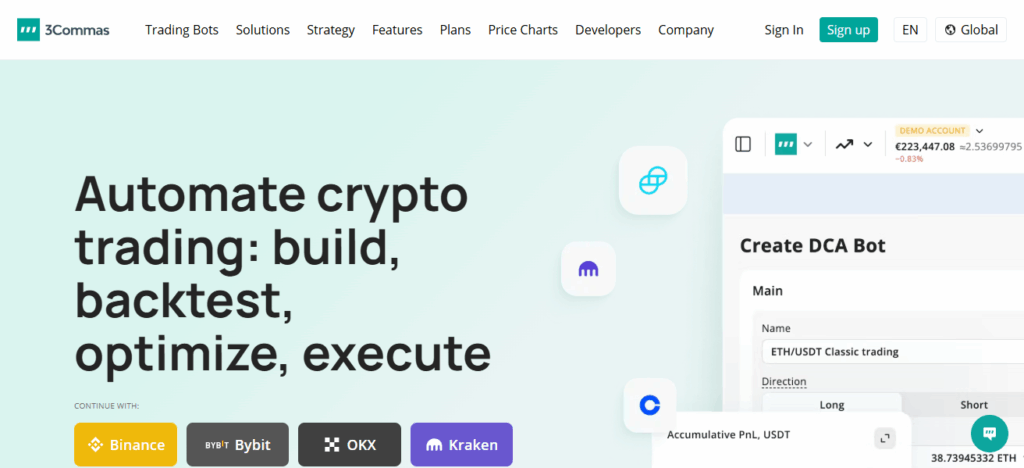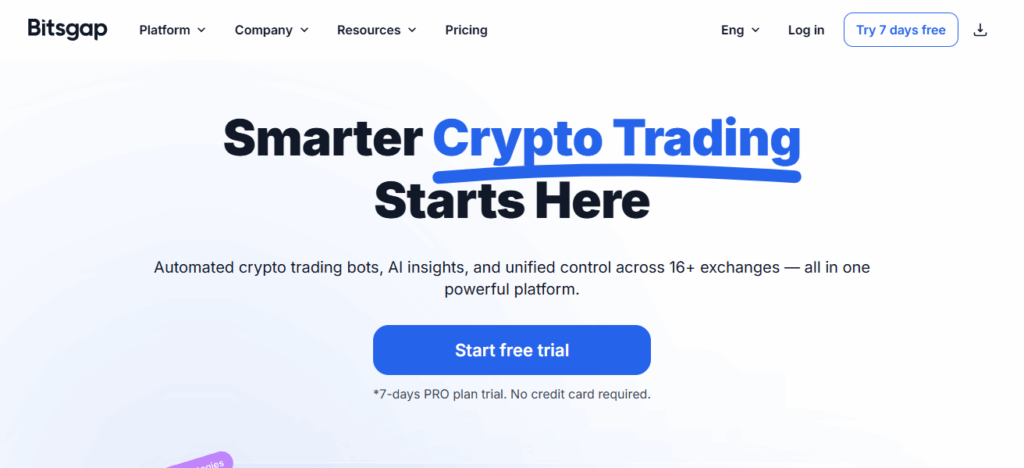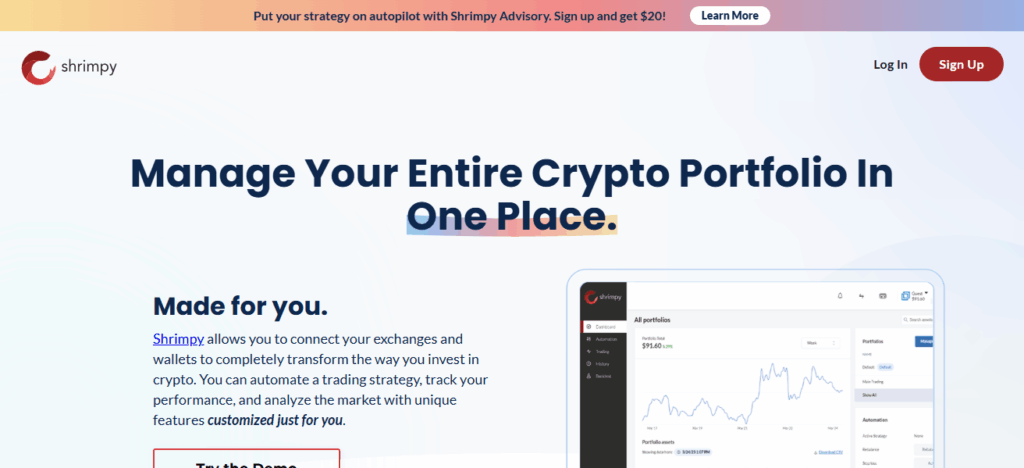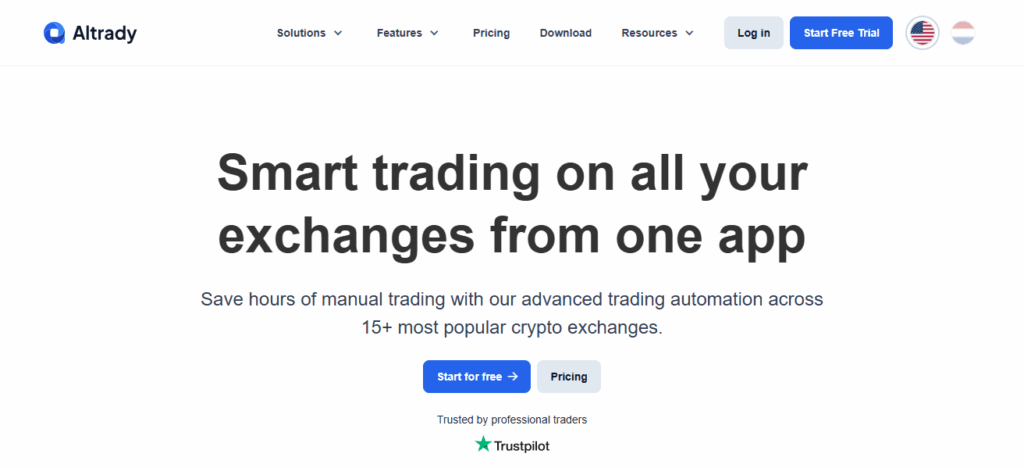In this article I will delve into the Best Crypto Exchanges for AI-Powered Trading Tools. As algorithmic and automated trading continues to developT
These platforms enable traders to access AI-driven bots, sophisticated strategies, and automatic trading across multiple exchanges simultaneously.
For novices, there are primitive user-friendly bots, and for seasoned traders, there is comprehensive customization. These exchanges provide great tools for improving trading profitability and risk control.
Key Points & Best Crypto Exchanges for AI-Powered Trading Tools
| Crypto Exchange / Platform | Key AI-Powered Feature |
|---|---|
| Pionex | Built-in AI trading bots for grid and arbitrage strategies |
| CryptoHopper | AI strategy designer and backtesting engine for automated trading |
| 3Commas | Smart AI bots with portfolio tracking and risk management tools |
| TradeSanta | AI-driven trading automation with customizable strategies |
| Bitsgap | AI-enhanced arbitrage and grid bots across multiple exchanges |
| Coinrule | Rule-based AI automation with pre-set templates for beginners |
| NapBots | AI-powered bots with trend-following and mean-reversion strategies |
| Shrimpy | AI-based portfolio rebalancing and social trading features |
| Altrady | AI insights for trade analytics and multi-exchange management |
10 Best Crypto Exchanges for AI-Powered Trading Tools
1. Pionex
Pionex is a crypto exchange that includes automated trading bots (such as Grid Trading, Infinity Grid, Spot-Futures Arbitrage) offering up to 16 free bots that novice programmers can use to automate their trades.
It charges a low trading fee (approx. 0.05 %) and captures liquidity from numerous exchanges, easing the use of automated trading for beginners.

Pionex does have a concern regarding user trust when it comes to internal exchange and routing operations.
Lastly, as with any bot, there are no guarantees of profit since the strategy and market conditions are the ultimate deciders.
Pros And Cons Pionex
Pros:
- The exchange includes trading bots (more than 12), and you do not have to do external integrations.
- Trading fees are very low (~0.05%) as a result of liquidity aggregation from major exchanges been and
- Excellent regulatory credentials and own security features: U.S. MSB license, bug bounty, cold storage.
Cons:
- Since it one exchange ecosystem, you are restricted with the coins and liquidity the exchange offers and are not true multi-exchange.
- Bots are simple to deploy but lack deeper configurations when compared to dedicated bot platforms.
- Users have complained about account freezes and slow customer support.
2. CryptoHopper
Cryptohopper is a cloud-based automated trading bot platform for numerous major exchanges, incorporating AI triggers, technical indicators, back-testing, and a social/signal marketplace.
It is designed for novice and expert traders, although there is plenty of user feedback highlighting its steep learning curv

Particularly regarding the cost of subscription and minimal output. Overall, CryptoHopper provides trading bots, but exorbitant subscription fee with subpar return.
Pros And Cons CryptoHopper
Pros:
- Strong multi-exchange support, works with many major crypto exchanges.
- User-friendly for mid-level users, especially compared to some of the more complex platforms.
- Marketplace/community features include copying strategies and using templates.
Cons:
- More complex than basic bots. Beginners might still find it challenging to configure.
- Some users mention technical issues and ‘overcharge’ problems.
- Higher subscription tiers lock advanced features. Costs increase.
3. 3Commas
3Commas is a popular trading automation platform that provides more advanced trading automation tools such as DCA bots, GRID bots, smart trading terminals, and multi-exchange support.
Due to its intricacy and versatility, it is better tailored to intermediate and advanced automation traders.

Some users appreciate its reliability and extensive customization options while others cite the steep learning curve and high costs.
3Commas is a solid option if you are aiming for algorithmic trading automation and are ready to dedicate the effort to its configuration.
Pros And Cons 3Commas
Pros:
- Powerful features include: advanced automation, multi-exchange, smart trading, DCA, and grid bots.
- Experienced traders can adapt and customize strategies to a high depth.
- Integrated analytics, back-testing, and portfolio tools.
Cons:
- Learning curve scaled to more complex.
- More expensive, thus, it may not be suitable if starting with a small budget.
- Customization offers no guarantees. It requires strategy and monitoring to achieve profit.
4. TradeSanta
With spot and futures automated trading support, signals, and an intuitive design, TradeSanta describes itself as an all-in-one crypto bot platform
It is typically recommended to traders who seek an uncomplicated automated trading experience and wish to avoid excessive complexity.

However, it does seem to lack advanced features, more extensive trading pairs, and exchange support as compared to more advanced automation tools
TradeSanta is a platform to bear in mind if you are new to crypto bots, looking for value for money and have automation requirements that are more than basic.
Pros And Cons TradeSanta
Pros:
- User friendly and budget friendly because of simple bot options (grid & DCA) and inexpensive plans.
- Multi-exchange support and simple interface for users who want automated trading without huge complexity.
- Supports both spot and futures, and bots have stop-loss and trailing features.
Cons:
- Compared to the top-tier platforms, the bot variety is limited (only the core types) – which means less advanced strategies.
- Compared to highly integrative platforms, exchange support is somewhat limited. (BitDegree)
- Users report issues: app glitches, bugs, etc.
5. Bitsgap
Bitsgap is an all-in-one crypto trading tool offering auto bots, portfolio management, algorithmic orders, and multi-exchange integrations for traders interested in automated trading across different platforms.
It is reported that the customer interface is quite friendly, although some respondents reported refund issues, and customer service was lacking.

For those traders that want a semi-automated trading experience, where trading can be done manually, and also with the bot integrated tools
The service offers a competent interface, although some customer caution regarding the service agreement is warranted.
Pros And Cons Bitsgap
Pros:
- Integrates with 15+ major exchanges – good for multi-exchange trading and arbitrage opportunities.
- Good bot variety and advanced automation tools: grid, DCA, smart order, portfolio tracking, etc.
- Free/demo plan available to test without full commitment.
Cons:
- Compared to simpler bot services or beginner tools, it’s more expensive.
- Operational complexity and risk increase because API keys are needed to connect to external exchanges.
- Because of breadth, the interface can feel overwhelming to new users.
6. Coinrule
Coinrule is a no-code automation tool focused on rule-based strategies. It provides pre-constructed templates, and via a drag-and-drop interface, users can build “if-this-then-that” strategies with automation for multiple exchanges.
For intermediate users looking to add some automation to their strategies and seeking a more straightforward interface, Coinrule is a good option.

The downsides are that the pricing for the higher tiers is quite steep, and some users have noted that the system is not fully “AI” and relies primarily on rule-based strategies.
If you want automation and prefer usability rather than deep customization, Coinrule offers a good solution.
Pros And Cons Coinrule
Pros:
- Very user-friendly drag-and-drop interface; no coding required.
- Good for intermediate traders who want automation without overload of advanced complexity.
- Supports strategy templates, back-testing, and demo mode for safer experimentation.
- Integrates with major exchanges and provides a simplified path into automated trading.
Cons:
- Because it is rule-based rather than deeply algorithmic/AI-driven in some cases, may not suit advanced traders seeking full flexibility.
- Pricing may be steep for what you get, especially compared to heavier platforms.
- Support for exchanges and advanced bot types is more limited compared to heavy-duty platforms.
7. NapBots
With minimal setup, NapBots can automate your trading directly to major exchanges using pre-designed quantitative trading strategies (bots) which integrate through API.
For users who don’t want to build their own bots, NapBots does emphasize simplicity and safety (funds stay on your exchange).

Like all automated trading tools, NapBots does not guarantee profit. Users will still have to ensure their market conditions and risk tolerance match with the trading strategies.
Pros And Cons NapBots
Pros:
- Offers pre-designed quantitative trading strategies (bots) connecting via API to major exchanges: minimal setup required.
- Enables you to benefit from data-driven strategies rather than manually input rules.
- Keeps funds on your own exchange (you control API keys) so potentially better custody control.
Cons:
- Due to their nature, pre-designed strategies will have limited customization.
- Depending on the market conditions, the subscription cost benefits and performance may be suboptimal and strategy quality may not cover the general risk.
- For true advanced customization or sizeable portfolios, limited compared to some market leaders.
8. Shrimpy
Unlike Shrimpy, which prioritizes portfolio automation and rebalancing along with limited high-frequency automated trading, does not include high-frequency trading.
User features include portfolio tracking, copy-trading, automated rebalancing, and strong security protocols (encrypted API keys, 2FA).

This service is expected for more passive or intermediate traders aiming to automate diversification instead of aggressive, core trading.
Shrimpy is for systematic portfolio management with basic automation, not aggressive trading with full-scale bot strategy execution.
Pros And Cons Shrimpy
Pros:
- For long-term investors who want to automate their portfolios and rebalance, they do not aggressively trade.
- Copy-trading, automatic rebalancing, and analytics are great to have for passive or intermediate traders.
- Strong security protocols (encrypted API keys, 2FA) and control over funds. (General)
Cons:
- They are designed as automation, which is not optimal for the more active strategies.
- Advanced platforms have more “bells and whistles” and ultra-fine control on the strategies.
- As always, automation/bots come with oversight and risk management on the user’s part.
9. Altrady
Altrady offers an automation platform and trade terminal that integrates with more than fifteen exchanges
Enables smart and trailing orders, and offers automation in trading and portfolio management with grid and signal bots, market scanning and bots, and other tools.
It is praised for its multi-exchange integration and provision of a comprehensive interface that facilitates both manual and automated trading.

Some drawbacks include a less than optimal mobile app, higher pricing for more casual users, and some functionalities being primarily focused on more seasoned traders.
If you trade on multiple exchanges and would like an automated interface to consolidate your tools, Altrady is a solution worth considering.
Pros And Cons Altrady
Pros:
- Practically worth it if you need a multi-exchange dashboard, since it connects to several exchanges, has a unified interface, smart/trailing orders, bots, market scanning.
- Useful for traders who want a consolidated tool for managing multiple exchange accounts.
- Useful for active traders due to sensible market alerts, multi-chart views and portfolio monitoring.
Cons:
- Free-trial, after which you pay; no permanent free plan.
- Strong on market analysis and alerts, but lacks deep AI-automated bot strategies compared to other focused platforms.
- Due to multi-exchange flexibility, users take loss for API security, broken connections, latency, etc.
- For smaller traders, the cost could be unreasonable, and if you want simple bots, the system’s complexity could be overwhelming.
Conclsuion
To sum up, the best crypto exchanges for AI-crypto trading tools balance automation, multi-exchange access, and easy interface for customers.
Pionex and CryptoHopper are for beginning and intermediate traders, while 3Commas, Bitsgap and Altrady are for more advanced traders who need more tools.
The right choice between these platforms depend on trading goals, risk profile, and degree of automation needed.
FAQ
They are automated bots or platforms that use algorithms, AI, or pre-defined rules to execute trades on your behalf.
Pionex and TradeSanta are beginner-friendly with pre-configured bots and easy setup.
3Commas, Bitsgap, CryptoHopper, and Altrady allow multi-exchange trading from one dashboard.
Most use API connections, 2FA, and encryption, but users must monitor and manage risk.
No. All automated trading carries risk and depends on market conditions and strategy.



